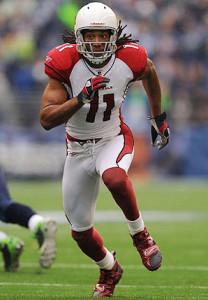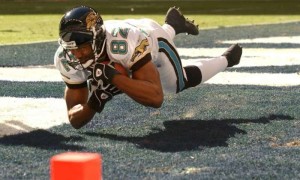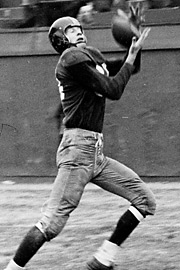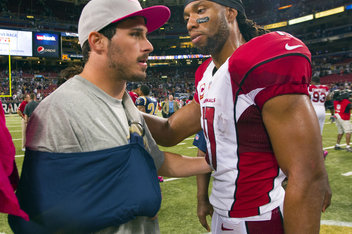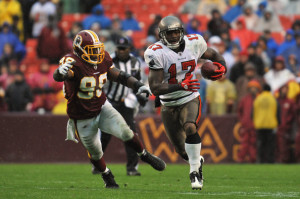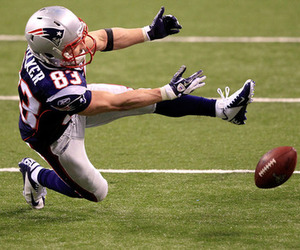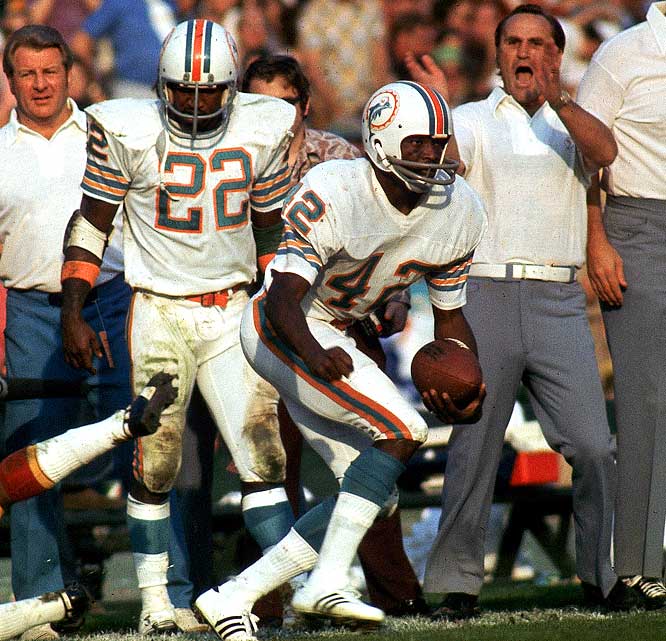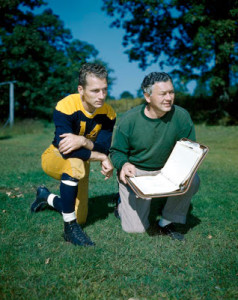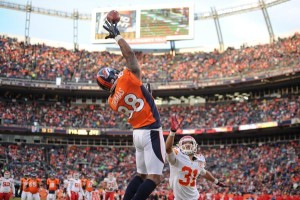Jerry Rice’s records are essentially unbreakable. Over a marvelous twenty-year career, Rice caught 41 more touchdowns than Randy Moss, 44 more than Terrell Owens, and 67 more than every player other than Moss and Owens. He also holds the overall touchdowns mark, with 33 more touchdowns than Emmitt Smith, 46 more than LaDainian Tomlinson, and over 50 touchdowns more than every other player in NFL history. If you check the NFL records books, no player has finished his career with more than 16,000 receiving yards and fewer than 22,895 receiving yards: that’s how wide the gulf is between @JerryRice and the rest of the great wide receivers.
But there is one record that possibly, maybe, hey you never know could be broken. Jerry Rice is the career leader with 1,549 receptions. For some perspective, Steve Largent was the first player to reach the 800 receptions mark, and Art Monk passed Largent in 1992. Rice caught the still-active Monk in the final game of the 1995 regular season. Monk would retire after the season with 940 catches to his name; as he laced up his cleats for the last time, he was the career leader in receptions. When he came off the field that day, he had been relegated to number two. That’s because 700 miles away, Rice caught 12 passes against the Falcons, bringing his career total up to 942. Oh, and Rice also set the single-season record for receiving yards that day, too. Rice turned 34 in 1996; up until that point, only Charlie Joiner (325) had recorded more than 300 receptions after his age 33 season. Even though Rice missed nearly the entire 1997 season due to injury, he still caught 607 passes after 1995. Which is why we always assumed this record was unbreakable.
However, as teams began passing more frequently (and more conservatively) than ever before, some modern receivers have compiled massive receptions totals. Did you know that Tony Gonzalez is number two all-time in career receptions? With 1,242 catches, Gonzalez has a 140-catch lead on #3 man Marvin Harrison, but Gonzalez still trails Jerry Rice by 307 catches.
But what about Gonzalez’ statistical doppelganger, Jason Witten? Four years ago, I wrote that Witten was going to find himself in the Hall of Fame because of his massive numbers:
Jason Witten entered the NFL at age 21. That’s very young for a player at any position, let alone tight end. So how has he done?
- Through age 22, he had more receptions and receiving yards than any other tight end.
- Through age 23, he had more receptions and receiving yards than any other tight end.
- Through age 25, he had more receptions and receiving yards than any other tight end.
- Through age 26 (the 2008 season), he had more receptions and receiving yards than any other tight end.
- With 40 receptions and 472 receiving yards in 2009, he will have more receptions and more receiving yards than any other tight end through the age of twenty-seven.
Witten hasn’t slowed down since I wrote that article. With 806 receptions, he has the most catches of any player through age 30 in history (although Larry Fitzgerald should catch him next year). I thought it would be interesting to chart the career receptions totals of Rice, Witten, and Gonzalez. The graph below shows the career receptions of each player at the end of each season, with age on the X-axis and career receptions on the Y-axis. Witten is in Cowboys blue and silver; unfortunately Chiefs fans, I chose to reserve red and gold for Rice, leaving Gonzalez in Falcons black and red.

Even now, Gonzalez has a lead on Rice, and he’ll be 36 catches ahead of Rice after 2013 even if he doesn’t catch a single pass. Of course, Rice went (literally) off the chart in his final years, making it essentially impossible for Gonzalez to catch him.
But Witten has basically had the same career as Gonzalez but with an even larger buffer against Rice. Witten’s lead on Gonzalez grew significantly this year thanks to a 110-catch season at age 30 (the year Gonzalez had just 73 catches), but ages 31 to 33 were ridiculous years for both Gonzalez and Rice. The odds are very much against Witten getting to 1,549 catches, but becoming the second player to hit the 1400-catch mark is a realistic (and incredibly impressive) goal.
The left columns in the table below shows the number of career receptions through each age for each of Rice, Gonzalez, and Witten. The right three columns show the number of catches by each player at each age.
Witten has a nearly 200-catch lead on Rice through age thirty. If we assume Witten can stay healthy in each of the next five years, he’ll get an even bigger buffer when he hits age 35. If we give Witten 351 catches over the next five years, he’ll be at 1157, giving him a 100-catch lead on Rice. Based on what Rice did after age 35, that’s not going to be anywhere near enough. If Witten wants a realistic shot, he’s going to need to keep pumping out 90-100 catch seasons for the next four years, at least. In any event, Witten will be able to keep this dream up for awhile: he needs just 38 catches in 2013 to end the year with the most receptions of any player through age thirty-one.

